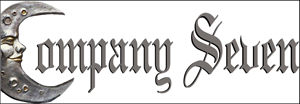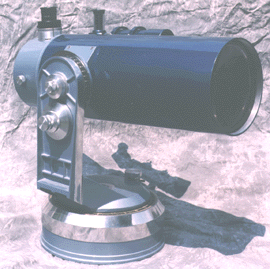
Optical Techniques, Inc.: A Brief History of A Brief Company
Discontinued product line, for information purposes only
 Above: Quantum 6 telescope Barrel mounted on it's Fork Mount. |
The Quantum 6 (S/N GI153211C) illustrated here is in the collection of Company Seven. It's design is nominally a 2,500mm focal length, f/16.8 Maksutov-Cassegrain system. Among the goals of Company Seven are the preservation and conservation of optical instruments that we consider to be historically significant, attractive or otherwise interesting. This instrument is now cased and on display at our showroom alongside other instruments. The caption near the telescope explains its history:
Optical Techniques, Inc. (OTI) became the most deliberate competitor to the Questar Corporation of the late 1970's. Questar's founder, Mr. Lawrence E. Braymer (b. 1901, d. 1965) a commercial artist by trade, was the originator of the concept of a portable multipurpose Maksutov-Cassegrain telescope that would be noteworthy for its excellence of materials and craftsmanship, and for an unprecedented ease of use. The high measure of user friendliness of the Questar is attributable to the cleverly engineered Control Box with numerous patented built in convenience features manufactured onto the rear of the optical tube. The original 3-1/2 Standard model telescope had been in development since 1946 and entered commercial production in 1954. After the death of Lawrence Braymer in 1965, his widow Peggy became the sole owner of the company. Mr. John Schneck worked at Questar since the days when the company was operated under its founder Lawrence Braymer. Mr. Schneck became Vice President at Questar, and his accomplishments there included supervising the development of the original Questar 7 telescope that was introduced in 1967. In 1976 Dr. Douglas M. Knight was hired as the new President by Mrs. Braymer. Soon after the arrival of Dr. Knight, 1977 culminated with a bitter management shakeup at Questar. Mr. Robert Richardson was among those who decided to leave Questar, he spoke with Mr. Schneck explaining that he was leaving and thought that a new company could be formed. Mr. Schneck agreed and they both left Questar to form OTI. Optical Techniques was was formally founded in 1976 by Mr. Richardson and Mr. Schneck, it was incorporated in 1976 with facilities being located in Newtown, Pennsylvannia about ten miles from the Questar Corporation facility in New Hope, Pennsylvania.
Rivaling the Questar telescopes in terms of optical design, aperture, and some convenience features, the OTI instruments were initially made to a similar quality as the Questar too. Mr. Schneck and Mr. Richardson believed that OTI could improve on the Questar product line by using the best of the Questar concepts and some component sources, then making what might be improvements of design and features.
Optics
OTI initially offered a 4 inch f/15 and 6 inch f/17 designs to compete with the Questar 3-1/2 inch f/14 and 7 inch f/14 models. The 4 inch model (95.3 mm clear aperture at the Corrector) offering 1.14x the light gathering power of the 3-1/2 with similar ease of use and portability. The quality too were similar since the Maksutov-Cassegrain optics sets for both Questar and for OTI were manufactured by the same optics fabricator in Maryland where these optics sets were made in small lots, originally figured to a similar degree of perfection as those made for Questar. With a similar focal length as the Questar 7 the Quantum 6 telescope shows a maximum actual field of view of about 1.1 degree, the same as does the larger Questar 7 telescopes.
In terms of mechanics the quality of raw materials, manufacture, and assembly was essentially similar to Questar while OTI was at its brief peak. The maker of the optics for both companies employed a premium quality Bosrosilicate Crown (BK-7/BSC-1) glass for the Corrector Lens. In its sales catalog OTI offered only Pyrex™ primary mirror substrate, while Questar offered Pyrex™ and the option of more thermally stable Cervit™. Starting in November 1979 Questar began to offer optional Zerodur™ substrate in place of Cervit™. Quantum offered a choice of either aluminized mirrors or optional high transmission silvered primary and secondary mirrors; the telescope serial number suffix indicates "C" if the silvered optics were furnished. In terms of figure, a Quantum 6 or Questar 7 might while at the lab test on the order of 1/4 up to 1/6th wave PV system, with a smooth RMS on the order of 1/20th or at times even better. However, as OTI began to experience financial difficulties the optical quality varied somewhat since OTI relaxed optical specifications requested of the opticians in an attempt to reduce costs. The focus mechanism of the Quantum was at the side of the control box and driven through a twisted flexible toothed belt; this is one aspect of the Quantum 6 in particular that caused several owners to later have conversions fabricated to provide a geared or direct drive. The optical tube includes a mounting bracket attached at the 9 o'clock position; this bracket incorporating a central 1/4 inch 20 tpi socket, this is the mechanism whereby it is attached to the Fork Mount.
Arrangement
The Quantum finish consist of natural polished aluminum, with light and medium blue painted control box and barrel, lens shade. Some areas of the Fork and Drive Base were painted too. The OTI telescope optical tube assemblies incorporate several features similar to those of the Questar including: a Control Box incorporating knobs with linkages to dial-in a Barlow lens to increase magnification, and another knob to select whether to pass the light path to either the eyepiece port or to the axial port. The Quantum finder telescope was a conventional arrangement attached onto the side of optical tube. The Quantum 6 shown here for example is provided with blue painted 7x 50mm finder telescope (made in Japan and then distributed in the USA by University Optics) with helical focuser, a 90 degree angled zenith prism, and polar alignment reticle eyepiece.
The Quantum OTA mount provided a single tine (arm) fork with a base incorporating manual controls for the friction driven Declination (elevation) and Right Ascension (azimuth) axes, a synchronous AC motorized clock drive driving the Fork and the Right Ascension setting circle, RA circle reading to 4 minutes resolution, and the Declination setting circle reading to 1 degree. The fork design permitted the user to quickly and easily remove the telescope barrel for transport, or deploy it for use as a telephoto lens or as a spotting telescope; this modular concept was similar to the Questar Duplex and Questar 7 arrangements. The Fork and Base were completely suitable to the task of supporting these telescopes rigidly, and tracking smoothly. In fact, the Fork and Base could be ordered alone, and we know of at least one instance where a customer installed a small Celestron optical tube onto his OTI Fork.
But a handicap of the OTI Quantum 4 (and Quantum 6) barrel arrangement was that unlike the Questar, the Quantum could not be rotated on the Fork Mount to vary the position the eyepiece as Declination or Right Ascension changed. This also meant that a birder or nature watcher who might place the barrel onto a conventional field tripod had to look into the eyepiece from the right side of the Quantum control box or devise some unorthodox solution. This was also true of the the Quantum 6, even while the Questar 7 Control Box eyepiece port is fixed at 12 o'clock. A lightweight alloy table top tripod leg set was provided with the Fork Mount, while an optional folding tripod with equatorial wedge was available. The tripods sourced by OTI were similar models from the same maker employed by Questar, so that the tripod sold for the Quantum 6 appears similar to that offered for the Questar 7 for example.
Both the Questar and Quantum telescopes could accept a variety of options including an Image Erecting Prism which attached to the axial port at the rear of the telescope to permit observing with 1.25 inch eyepieces in line with the barrel. Other Quantum hardware options included: prime focus and eyepiece projection camera adapters, eyepieces, hard wood carrying cases for the OTA and for the Fork and Base, Solar Filter for the OTA and another for the Finder, a Binocular Viewer (a modified Leitz microscope accessory), and turret eyepiece holder.
Quantum 100
In an effort to simplify production and to moderate selling prices OTI developed the Quantum 100. This would be based on the Quantum 4 optics and it featured a simplified optical tube and single tine fork mount with electronic synchronous RA Drive. The Optical Tube Assembly of the Quantum 100 dispensed with with the Control Box of the Quantum 4, and this provided the user instead with a simpler Visual Accessory Back with 1.25 inch diameter, with 90 degree angled diagonal, and 1.25 inch eyepiece. The Fork Mount was a open sided, triangular Fork Tine atop an angular Base, all finished in black. As with the Quantum 4 telescopes, the OTA was mated onto the Fork Tine by a fitting attached at the 9 o'clock area along side the optical tube. Since the diagonal permits the rotation of an eyepiece to just any position around the rear of the Quantum 100 (not having the eyepiece port fixed as on the Quantum 4), the Quantum 100 could have been dismounted from the Fork and used atop conventional photo tripod heads. We are not sure if any of these telescopes were sold, but at least one was made and this appeared in OTI marketing literature.
Sales and Decline
OTI sales were handled factory direct and through three representatives one in Pennsylvania, Illinois, and in California. The advertisements were in the usual astronomy media and were of professional quality, and realistic in content. The marketing emphasis was on optical and mechanical quality. Quantum telescopes were sold for lower cost than the competing Questar telescopes.
It appears that OTI reached its zenith in 1978 or early 1979 however, the company had been operating at a loss with loss per instrument estimated to be about $200 per 4 inch model sold, and worse for the larger instruments. This was apparently not realized by the proprietors of OTI in time to defray collapse of the company. By 1979, OTI deliveries were running later than usual and at times orders were sent incomplete: the original owner of the Quantum 6 on display at Company Seven for example received the barrel in a nicely finished wood carrying case; the Fork Mount and Base also arrived but he never did receive the wood carrying case promised for the mount. On 1 September 1979 a new price list was issued adding the 8 inch Barrel to the line for $2,365 with mount being optional. In February 1980 the last of the total 288 sets of 6 inch optics were delivered to OTI. We estimate that OTI sold 645 - 4 inch models (one S/N 634 was in Zerodur™), and only eight sets of 8 inch optics were delivered to OTI. By mid 1980 OTI had discontinued operations. Mr. Schneck went on to establish Davro Optical Systems, a firm which offers Maksutov-Cassegrain optics based systems to government and industry.
Quantum 6" Telescope S/N GI153211C on display at Company Seven
Serial No. GI153211C, 6" Optics Set #219 (made in May 1978), 2,519mm e.f.l.
- 29 March 1979 Telescope ordered (based on 1 Oct. 1978 Price List) $1,795.
- Enhanced Silver Mirror Coatings (listed as 20% improvement) $245.
- Dew Cap/Lens Shade $40.
- Set of Tripod Legs and Base Adapter $47.50
- Base Carrying Case, and Barrel Carrying Case
6 April 1979 Customer received confirmation letter from Paul G. Schenke (Sales Manger)
- with delivery scheduled for week of 11 July.
25 July 1979 Customer received ready to ship notification from Betty Nikon (Office Manager).
1 May 1993 Telescope acquired for permanent display at Company Seven.
Contents Copyright 1994-2008 Company Seven - All Rights Reserved

